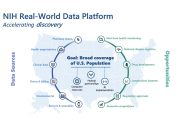
Is health insurance under ObamaCare headed for a “death spiral” of increasing premiums as a result of an influx of older, less healthy individuals into the insurance market?
“According to figures released [January 13] by the U.S. Department of Health and Human Services, only 24 percent of the 2.2 million people who have already signed up for Obamacare are between the ages of 18 and 34, just a little more than half of the 40 percent the administration admitted it needed to keep premiums affordable,” reported CNSNews.com.
This makes sense considering that premiums for those individuals are rising to offset the cost of covering older and sicker individuals, whom insurers must now cover at rates comparable to those being charged to people expected to draw few benefits. If not enough young, healthy people buy coverage, insurers will be forced to raise premiums on existing policyholders, which will encourage even more young and healthy individuals to drop coverage, leading to another round of rate hikes, and so on, until the health-insurance industry goes under.
Despite the lackluster enrollment figures for young adults, the Washington Post’s Ezra Klein declared, “The risk of a ‘death spiral’ is over.” Klein based his opinion in large measure on a December Kaiser Family Foundation report arguing that even if young, healthy individuals do not buy health insurance in large numbers, insurance premiums will not rise significantly.
Not everyone shares Klein’s optimism.
“I think there is a significant problem here,” Dr. John Goodman of the National Center for Policy Analysis told CNSNews.com. “I think the insurers are worried. I think the administration is worried.”
“Remember, everybody is facing the wrong price,” Goodman explained. “And sick people are facing a price that’s well below the cost of their care. Young healthy people are being overcharged. And so they need lots of young healthy people to join so they can get the money to pay the bills for the sick people. And the younger people just aren’t buying it.”
Besides the high premiums, Goodman suggested that the numerous problems with Healthcare.gov and some state exchange websites have also contributed to the failure of young, healthy people to enroll. “The only ones who’ve persevered — sometimes trying a hundred times — are people who really have serious health problems,” he said. They, after all, have much to gain — namely guaranteed coverage at below-market rates — by enrolling, while the young and healthy have little to gain and much to lose by doing so.
ObamaCare offers four levels of coverage: bronze, silver, gold, and platinum, with bronze the least generous and platinum the most generous. Klein included the fact that “people are opting for reasonably generous plans” — 20 percent of enrollees have selected gold or platinum plans, while 60 percent have chosen silver plans — among his reasons for dismissing fears of a death spiral. But as Goodman pointed out, the reason people are buying the more generous plans is that they “tend to be sick” and “plan to use a lot of health care.”
Furthermore, observed the Weekly Standard, most enrollees are choosing silver plans for one simple reason: “cost-sharing subsidies are only available to Americans who have enrolled in a silver-level plan.” Those subsidies, available to Americans earning less than 250 percent of the federal poverty level, help reduce their out-of-pocket medical expenses.
Then, of course, there are the income-based subsidies for the purchase of health insurance itself, applicable to people earning as much as 400 percent of the federal poverty level. All told, said Goodman, “80 percent of all the people who signed up so far are getting subsidies.” This is a problem for taxpayers, insurers, and the Obama administration. “Well, they need lots of people who have higher incomes and who aren’t going to get subsidies,” Goodman continued. “And if those people are unwilling to pay the high premiums that are being charged, then they’re in trouble…. Everybody is worried, and no one’s keeping the fact that they’re worried a secret.”
Klein also wrote that he doesn’t expect a death spiral because of “the transitional policies in Obamacare that help insurers keep premiums low as the risk pool sorts itself out over the first three years.” To bolster his case, he quoted insurance-industry consultant Robert Laszewski: “I think the 2015 rates will be the rates you’re looking at today, more or less.”
What Klein failed to mention, however, is that Laszewski himself stated in a blog post that he believes ObamaCare “is in very serious trouble.” Laszewski cited “far fewer people signing up than expected, enormous negative publicity about website problems, rate shock, big average deductibles, narrow provider networks, and a general growing dissatisfaction over the new health law” as reasons for his assessment of ObamaCare’s health. And while he did argue that rates aren’t likely to shoot up in 2015, that’s mostly because the federal government, via a tax on health insurance, is subsidizing insurers’ costs of covering the previously uninsured sick — the “transitional policies” to which Klein alluded. As those subsidies wind down, Laszewski expects insurers to increase their premiums to more appropriate levels, probably beginning in 2016. That may be when the death spiral begins to pick up speed.
Another contributor to the death spiral will be the dumping of government retirees onto the insurance exchanges. “Over the next three months, the federal government will end its risk pool and all the state governments will end theirs, and then all those people who are high-cost enrollees, they will go into the exchanges,” Goodman told CNSNews.com. “And then there are cities and towns like Detroit, that have made promises of post-retirement care and they’re not funded, and so Detroit’s planning on sending all of its retirees to the exchange, and lots of other cities will do the same thing.”
“And then the Obama administration’s apparently going to allow hospitals and AIDS clinics to enroll people on the spot,” Goodman said. “So if a hospital had a patient who’s having heart surgery, for example, that hospital is going to be able to get him enrolled in a private plan in the exchange to shift the cost over to that insurer. Apparently the hospital can actually pay the premium for the individual.”
“You see, the premium is small compared to that hospital bill. So if we’re talking about a $50,000 hospital bill, they can afford to pay a $10,000 premium and come out ahead. So insurers are sort of quite vulnerable at the moment.”
All of this suggests that Goodman and other ObamaCare skeptics are right to fear for the future of private health insurance in America. Goodman also worries that even if ObamaCare were repealed, it would be difficult to revive the individual insurance market because it’s been “destroyed.”
“We need to think carefully about how we can get out of the mess we’re in,” he said, because “just repealing the legislation isn’t going to be enough.”
Perhaps not — but it would certainly be a good start.




